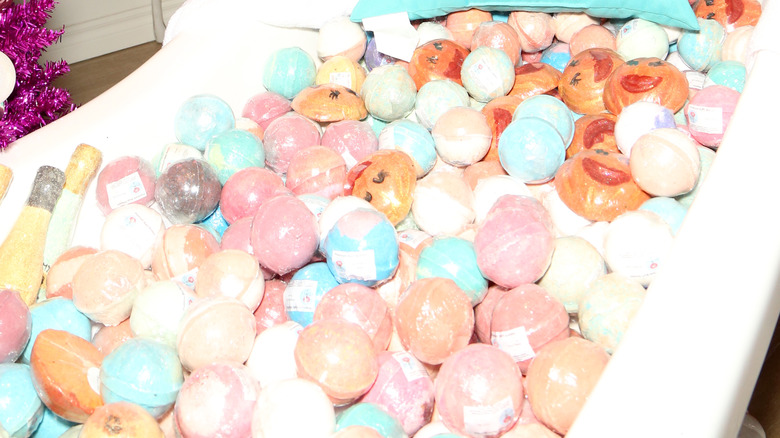Big Mistakes To Avoid When Making Your Own Bath Bombs
Bath bombs are the coziest way to relax after a long day (or a cozy way to begin your day — we won't tell). They transform the standard bath into a whimsical one, both turning your bath water into a colorful paradise and often infusing it with essential oils and other goodies to help you fully dissolve into the bath. Because they've become such a hot commodity in recent years, people have begun making bath bombs at home in larger quantities, but there are certain pitfalls you want to avoid when making them yourself. For example, there are certain ingredients you want to avoid in the bath bomb making process (and you can watch out for these when buying bath bombs, too).
While making bath bombs at home may sound intimidating, it's worth a shot because of their positive attributes. According to Bath Bomb Fizzle, bath bombs are vegan and all natural, meaning you can be comfortable with what your body is being exposed to. They're also soothing for your skin, as they moisturize and soften it due to the enhancements they release into your bath water. They even simply create an atmosphere that's conducive to relaxation and physical and mental regeneration. Because of this, it's worth looking into making bath bombs, and we've got you covered on how to best approach this process.
Citric acid may be the most important ingredient in your bath bomb
A particular balance must be achieved when making homemade bath bombs, and it's this equilibrium that often causes people the most trouble at home. According to Daisy's Beauty Jewels, bath bombs can easily become too dry or too wet. If they're too wet, they won't hold their shape, and if they're too dry, they crack and crumble and don't form their ball shape. Your mixture should be the texture of kinetic sand before you mold it, meaning that it's slightly crumbly, but still holds its shape when clumped together.
The order in which you add your ingredients matters too. Citric acid, for example, should be added after your other liquid ingredients (via The Homestead Challenge). Adding it too soon can cause chemical reactions that will make your mixture expand, meaning you'll never get actual bath bombs. This also means that your bomb, if it does set, won't fizz much in the bath because the chemical reaction between the acid and the baking soda already played out in the mold or your mixing bowl.
Similarly, you want to research recipes before you use ingredients such as coconut oil. Coconut oil is solid at room temperature, but it melts easily, so if you use it as a structural element, you might be in trouble if your house warms up throughout the day.
Still, though, even if you run into mistakes and your end product isn't a perfect bomb shape, you can still use what you've made. You can try to fix it by letting it sit overnight (drying it out), or you can use it as a bath dust, which will still dissolve in your water (via The Soap Guy). Since there's a reward no matter what, you should try making them for yourself!

